


June 13, 2010
Volume II, Issue 9
www.303rdBG.com
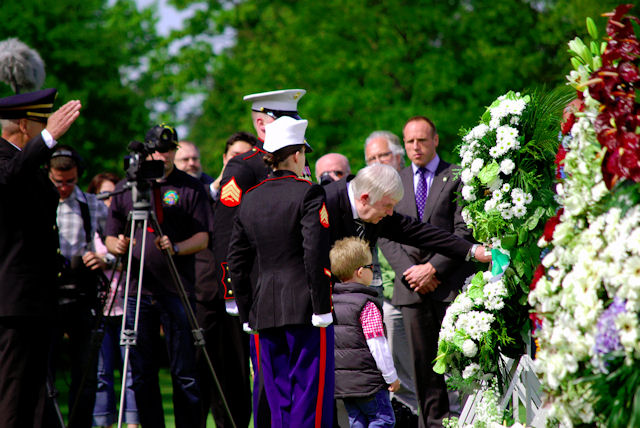
Passing the Torch
An older gentleman talks to his grandson as they lay a wreath dedicated to fallen WWII American
soldiers at the 2010 Memorial Day Ceremonies at the Ardennes American Cemetery and Memorial on May 29.
by Dr. Peter W. Schramm
Memorial Day is a day unlike any other. Since 1868 we have come together in our communities, towns and villages, to place flowers and flags on the graves of those who have given their last full measure of devotion to our country. We have come here to remember and honor those who have done their duty, as God allowed them to see that duty.
Let me cite a few facts—incomplete facts—before I say anything else, because facts have a way of not allowing you to ignore them. Facts are brutal.
- In 80 months of the Revolutionary War there were 10,623 casualties, with 4,435 deaths, or about 55 Americans dying each month of the war.
- In 37 months of the Korean War there were 136,935 casualties, with 33,651 deaths, or about 909 Americans dying in combat each month of the war.
- In 90 months of the Vietnam War there were 211, 471 casualties, with 47,369 deaths, or about 526 Americans dying in combat each month of the war.
- In 1 month of the Gulf War there were 760 casualties, with 293 deaths, or 148 Americans dying in combat during the month of the war.
- In 14 months of fighting in Iraq, there have been 4,685 casualties, with 803 deaths, or 57 Americans dying each month of the war.
 Those Americans who died in all these wars—and more could be mentioned—did their duty, and we know who they are, as we visit the cemeteries and note the dates of their shortened lives on the headstones. We know their loved ones, their wives and mothers, and their children, and the friends who shall always miss them.
Those Americans who died in all these wars—and more could be mentioned—did their duty, and we know who they are, as we visit the cemeteries and note the dates of their shortened lives on the headstones. We know their loved ones, their wives and mothers, and their children, and the friends who shall always miss them.
But let me mention another war, the Big One—ominously numbered with a two, not only because there was a previous war that was thought to be a world war, but because reasonable men rightly assumed there might be more such huge conflicts that would literally embrace the globe—World War II. This was a time when good and evil contended for the world. The largest things were at stake.
It is this war that I want to especially note and remember here today.
- In 48 months of World War II there were 1,078,162 American casualties, with 407,316 deaths, or 6,639 Americans dying in combat each month of the war.
And, after the well-deserved victory in this World War—like the generous people that we are—we helped rebuild their countries; we wrote constitutions for the defeated, and insisted that their regimes turn toward democracy and rights. Instead of enslaving the defeated, we set them free. At their finest hour these Americans treated their vanquished with magnanimity. It is no wonder that the 20th century has come to be called the American Century. For this Americans will be remembered until the last generations.
How is it possible to honor such men, both the dead and living? Perhaps we cannot do any better than to call you the Greatest Generation of the greatest country in the world. Perhaps we should make certain that your stories are told to the young. Perhaps we should try to imitate both your purposes and lives, in both peace and war. Perhaps we should just sincerely thank you for making sure that this island of liberty would continue. Perhaps we should just say this, along with Abraham Lincoln: "Gold is good in its place; but living, brave, patriotic men, are better than gold."
We are in your debt and we thank you. May God always bestow His blessings upon you.
303rd BG Veterans Honored at the Group's 1942 Base
Boise, Idaho – May 27, 2010
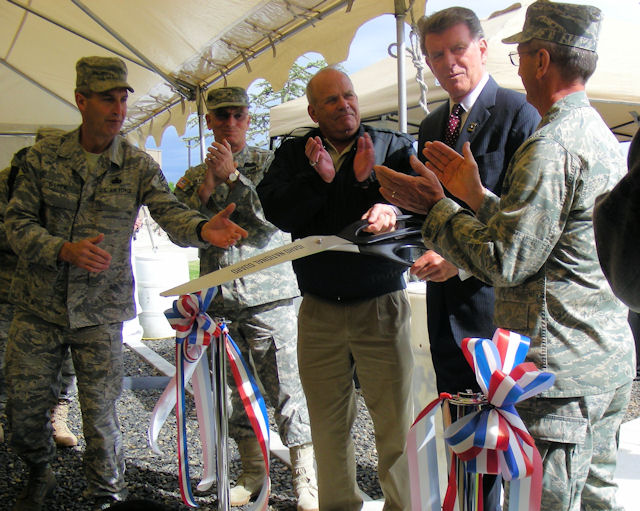
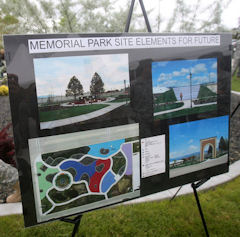
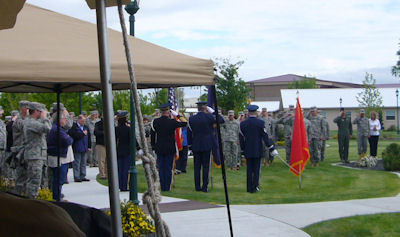
(Left) Chart showing the future layout of the Memorial Park. (Right) Attendees stand at attention
while the Colors are presented. About 150 military and civilians attended the ceremony.
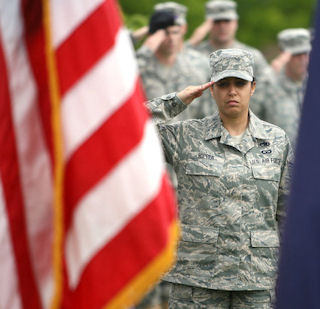
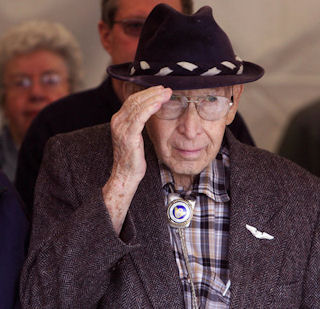
Snappy salutes from members of the Idaho National Guard, and one from 303rd BG Pilot Jack P. Rencher.
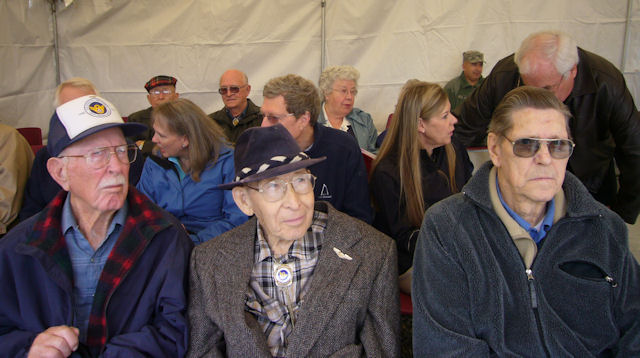
303rd BG veterans Loyd Coleman, Jack Rencher and Fred Gano were center stage at the ceremony.
About 18 friends and family supported the three 303rd BG veterans. Some are shown in the background.
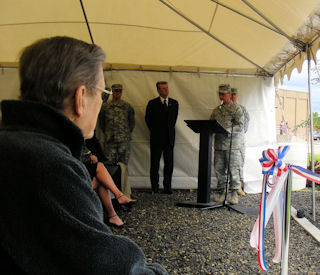
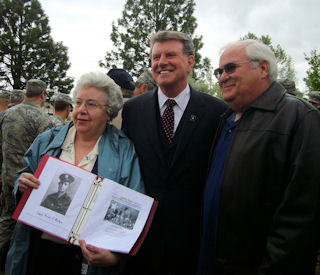
(Left) 427th BS Pilot Fred Gano watches the ceremony from the front row of the VIP tent.
(Right) Governor "Butch" Otter poses with Nathelle Bales Oates and Gary Moncur. Mrs. Oates is the sister
of 359th BS Pilot Ross C. Bales, who was killed in action on May 14, 1943. She is holding his photograph.
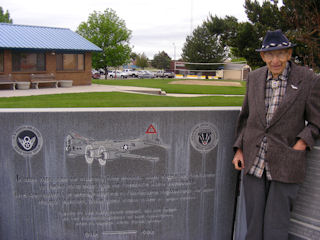
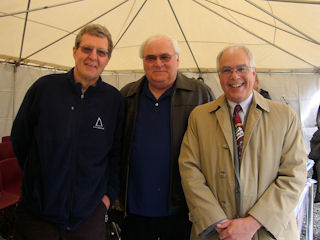
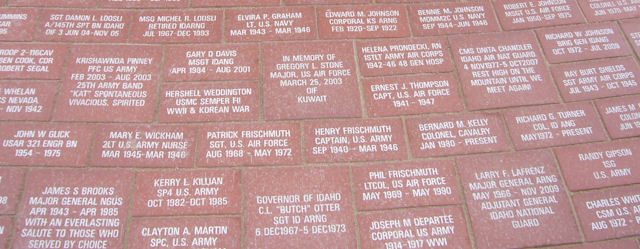
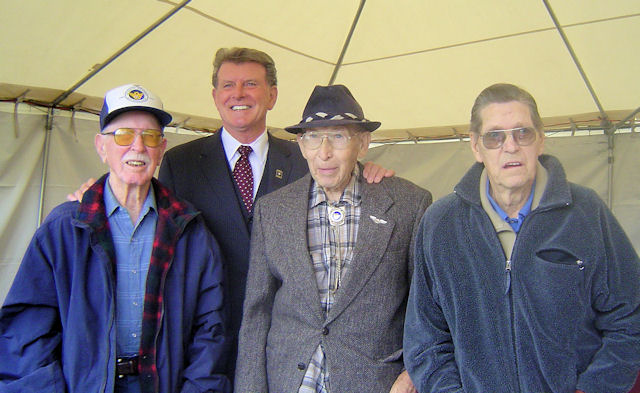
Loyd Coleman, Idaho Governor C. L. "Butch" Otter, Jack Rencher, Fred Gano
Written for the Kuna Melba News by Madge Wylie
Sixty-five years ago Loyd Coleman was on a routine flight over enemy territory. He was the tail gunner on a B-17 that had flown several missions. It was New Year’s Eve, 1944, and his 16th mission, when one of the engines caught fire and they were unable to feather the prop. In the tail section Loyd periodically reported on the vibration, which was felt sharpest in that area. The engineer went up front and tried to jettison the nose escape hatch, but lack of oxygen at that altitude made him pass out. On a quick appraisal it was decided that the crew should bail out. The ball-turret gunner, the waist gunner, the radio operator and Loyd bailed out. Being at 27,000 feet altitude and with no chance of exiting the plane without a chance of freezing the limbs, and thinking that the plane was going to fall apart at any moment, Loyd ascertained that he was the first one out. He plummeted about 15,000 feet before pulling the ripcord. A hard landing on frozen, plowed ground twisted his knee and knocked him out.
When asked if he was frightened that someone would shoot at him, he said “No, I was so damned glad to get out of that plane that after I opened the ‘chute, I actually chuckled.”
As he drifted, he said the scariest part was that part of the time he was over water, then over land (there were so many inlets) and he was afraid that he would land in the water.
Although they had bailed out over enemy territory, the wind carried them into Belgium. He was quickly surrounded by farmers and other people with pitchforks and shovels in their hands, but when he showed them his American Army Air Corps insignia, someone ripped the door off a building to use for a backboard to carry him. They took him into the home and put him on a feather mattress. A short time later they rushed him in a jeep to an English hospital. He took a trolley into Antwerp, but they had just been bombed and there was glass and debris all over the streets. He had a time finding his way to a American Field hospital and he said he was just about “done in”. From there he went to an evacuation point near Brussels. They, in turn, kept him a week. He begged them to let him get back to England to his unit, so they let him go when he gave them his silk parachute. He caught a C-3 transport to Molesworth, his former base. It had been thirty days to the day since he had bailed out. After a short stay he was returned to his squadron. He found out later that the others were scooped up and sent back to the base in England.
He was told later that the pilot, with four remaining crew members on the plane, plummeted to about 15,000 feet and were able to feather the prop on the bad engine and the speed put out the fire. They landed safely in England at their base.
His 17th mission was over Berlin. The 17th through the 28th missions were with his original crew. They were finishing their 35 missions while he was spending time getting back from his landing in Belgium. From the 29th to the 30th mission he was with two other crews. Upon his pleading he was released after the 30th mission and sent home with the crew he had started with – the 427th Squadron of the 303rd Bomb Group of the Eighth Army Air Corps. Following the war Loyd returned to his home town of Melba, Idaho, built a garage, owned and ran a gas and oil bulk plant, farmed his small place in addition to his parents’ farm, and became an entrepreneur of Limousin cattle, which he showed all around the Northwest.
Always, through all the years of operating his own businesses and raising a family, he kept in touch with the members of his B-17 crew. He subscribes to the Molesworth Pilot, a newsletter which keeps him in touch with all the survivors and families of the 303rd Bomb Group, a portion of the Eighth Air Force in which he served his time during World War II. And, although his eyesight is nearly gone, he reads political and patriotic communications on his computer.
On Thursday, May 27, Loyd, along with two other local veterans of the 303rd, Jack Rencher and Fred Gano, was recognized for his service, during the dedication of the newly finished Gowen Field Memorial Park. He attended the ribbon cutting ceremony performed by Governor “Butch” Otter and dignitaries of the Gowen Field National Guard.
On June 22 he will be 93 years old.

General Dwight D. Eisenhower's Message to the US Forces:
"Soldiers, Sailors and Airmen of the Allied Expeditionary Force! You are about to embark upon a great crusade, toward which we have striven these many months. The eyes of the world are upon you. The hopes and prayers of liberty loving people everywhere march with you. In company with our brave Allies and brothers in arms on other fronts, you will bring about the destruction of the German war machine, the elimination of Nazi tyranny over the oppressed peoples of Europe, and security for ourselves in a free world."Your task will not be an easy one. Your enemy is well trained, well equipped and battle hardened, he will fight savagely.
"But this is the year 1944! Much has happened since the Nazi triumphs of 1940-41. The United Nations have inflicted upon the Germans great defeats, in open battle, man to man. Our air offensive has seriously reduced their strength in the air and their capacity to wage war on the ground. Our home fronts have given us an overwhelming superiority in weapons and munitions of war, and placed at our disposal great reserves of trained fighting men. The tide has turned! The free men of the world are marching together to victory!
"I have full confidence in your courage, devotion to duty and skill in battle. We will accept nothing less than full victory!
"Good Luck! And let us all beseech the blessings of Almighty God upon this great and noble undertaking."
The 303rd Bomb Group flew three missions on June 6, 1944 in support of D-Day. Special mission instructions were issued to best ensure destruction of targets and to protect the invasion troops:
- If bombing was visual, it would be done by Squadron formation on the Squadron leader.
- If bombing was done by PFF on an obscured target, it would be done in Group formation on the PFF leader.
- All bombing would be done exactly within allotted times. Careful synchronization of all navigator watches was made. In no instance would a second bomb run be made.
- Every precaution would be taken to ensure that no bombs fell short, to protect landing craft.
- All formations would carefully observe assigned intervals, timing, and altitudes between Groups and Squadrons.
- After "zero" hour, no bombs would be released in the beach area.
359th BS 1Lt William J. Arnold Crew
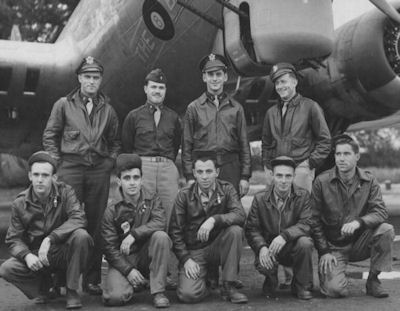 |
This "longest day" began early, with the crews being awakened at 2:00 a.m. At the crew briefing at 3:30 a.m., John Surrell remembers the briefing officer pulling back the curtain to show the mission map and announcing, "Gentlemen, today is the day, D-Day. If you ever thought about not screwing up, today is that day!" The officer went on to give a terrific pep talk. Each crew member was given a copy of General Eisenhower's message of good luck to all the soldiers, sailors and airmen participating in the invasion. Surrell recalls the Arnold crew being a little surprised to learn about the invasion, although they assumed it would happen at some point.
The 6:22 a.m. take-off for the first mission was almost a disaster. The Bonnie B was heavily laden down with its regular complement of twelve 500-pound bombs and a 1,000-pound bomb attached under each wing. B-17s are slow climbing planes. With this load, Arnold was able to just barely pull the plane into the air at the very end of the runway. The Bonnie B gained altitude so gradually that the plane hit a haystack in a field about a half mile beyond the runway. Fortunately this accident did not damage the plane and incredibly the B-17 pushed higher into the air immediately after the collision.
The five-hour mission itself, however, was a disappointment because heavy cloud cover prevented the crew from seeing the beachhead or dropping their bombs. Walter Cronkite, who was then a young UPI correspondent, flew aboard the "Shoo Shoo Baby," just four planes ahead of the Arnold crew. The famous CBS journalist described the mission in his autobiography, A Reporter's Life (1996):
The weather was lousy, but through the broken clouds I had a good look at the unbelievable armada of Allied ships. There didn't seem to be room in the ocean for another vessel. And then, just as we approached the beach--blackout. The cloud cover was total.The Bonnie B's landing (11:36 a.m.) was particularly dangerous for the Arnold crew because the 1,000-pound external bomb under the right wing partially released as they touched down, and began scraping along the runway. Arnold averted disaster by quickly veering the Bonnie B onto the dirt adjacent to the field.Our bomb bay doors were open, our bombs were armed to go off on contact. But we couldn't see the target. And we couldn't see our own planes flying in close formation on either side. Any collision would probably set off a chain explosion, wiping out the squadron. Normally bombs would be jettisoned over enemy country, but our orders forbade that. No one knew in that first hour where our airborne had landed or even how far ashore the landing troops might have gotten.
Squadron leader Lewis Lyle led that potentially explosive flight up through the clouds. When we broke out, he planned to make a full circle and try again for the target, but then he recalled that during his briefing he'd been told that there would be so many planes at so many altitudes that strict flight patterns had to be observed and that meant returning home. We landed on a fog-shrouded runway with those bombs still armed. Now that was a hairy landing.
It was not until after they finished lunch that the Arnold crew learned they would
be flying a second mission. A staff sergeant told the crews that "You did so well this
morning that you get to go back again this afternoon." Between missions, Stanley Claster
found time to nap for an hour and spend a half-hour reading about 15 letters from home
that had been forwarded from his last US base.
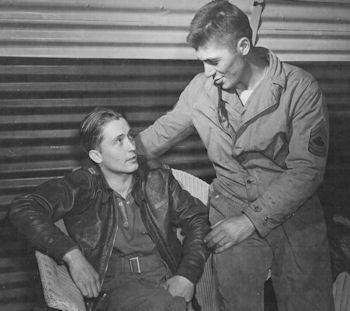 |
Folmer, known during his service with the 303rd Bomb Group at Molesworth as "Fabulous Fabian" was the Crew Chief on the famed B-17 Flying Fortress "Hells Angels," the first 8th Air Force bomber to complete 25 missions over occupied Europe.
At the end of the day, the flag was lowered in a military ceremony, and presented to the JAC Senior Enlisted Leader, Master Chief John C. Frakes. It was then sent to Mrs. Donna Folmer, the widow of Master Sgt. Folmer.
Last year the Joint Analysis Center at RAF Molesworth created the "M/SGT Fabian S. Folmer Award for Excellence in Support Services" in honor of M/Sgt Folmer. The first recipient of the award, presented last January, was Navy Chief Petty Officer Charles J. Mosbarger.
For more information see:
http://www.501csw.usafe.af.mil/news/story.asp?id=123158367
http://www.501csw.usafe.af.mil/news/story.asp?id=123185289
Author and Film Crew to Interview 303rd Veterans at 8th AF Reunion in Tucson
by Stephen Frater
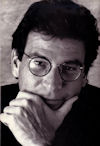 |
The following is brief summary of my book:
"In the summer of 1944, as the European air war entered its climactic phase, the unlikeliest man ever to pilot a United States Army Air Force B-17 Flying Fortress bomber was Werner Goering, the Utah born and raised nephew of Nazi Reich Marshal Hermann Goering, Adolf Hitler’s right hand man and heir apparent. The almost equally unlikely man flying in the co-pilot’s seat next to Werner was Jack Rencher, the Arizona born and raised, high school dropout son of a Jewish schoolteacher and a Mormon rancher.
"Jack’s orders from the FBI’s J. Edgar Hoover and the highest echelon of U.S. military intelligence: Shoot to kill Werner if for any reason – a treasonous decision on Werner’s part, enemy fire, or even mechanical failure – their plane could not get to its base or another Allied airfield.
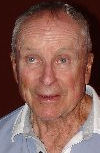 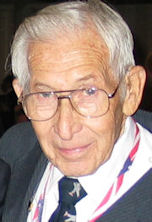 |
My New York based literary agent Michael Carlisle of Inkwell Management proposed we send a professional film crew to Tucson to film the July 21-24, 8th AF reunion, where Werner and Jack will see each other again for the first time in over a decade. It will be also the first reunion Werner, who completed 49 combat missions, has ever attended in the 65 years since the war ended.
We plan to follow Werner and Jack around some of the events and also give other 8th and 303rd veterans an opportunity to share their memories on film for posterity. As the date approaches, I will send you the exact filming schedule, but I expect we will film at the Pima AF hangar where the B-17 serves as a great backdrop and will visit the hospitality suites where the vets will be staying at the Holiday Inn.
More information on the reunion follows below.
Eighth Air Force Reunion – Tucson, Arizona – July 21-25, 2010
The countdown is on for our Mission to Tucson!
As our annual reunion draws near, the registrations are coming in...how about yours? You do not want to miss this wonderful opportunity to share in the friendships with your fellow 303rd veterans.
The 8th Air Force Historical Society has arranged a spectacular agenda... full details can be found here -- http://www.8thafhs.org/reunions.htm -- or in the current issue of the 8th's magazine. (Note: If you are still in doubt, but think you will be able to attend, book your hotel reservations now.....These can be canceled up to the last day without penalty).
A special note to all of you "NexGeners" : You are the future of the 303rd...please come and show your support to the veterans and their families. The rewards are great and you will be doing your part to continue the legacy of the incredible 303rd!
Please join us...you'll be glad you did. See you in Tucson!
"Thunder over Michigan" – The Largest Gathering of Heavy Bombers in the World
The 8th Air Force Historical Society is hosting veterans, family members, and their guests at the Willow Run Air Show, located just outside Detroit, August 5 thru 8, 2010. The Air Show organizers are expecting 8 to 10 B-17's to attend, 2 B-24's, 12 P-51's, the usual cadre of other WWII aircraft, as well as a flying ME-262 and an ME-109. More information is available here: http://www.8thafhs.org/detroit.htm
 Molesworth Main Gate ?
Molesworth Main Gate ?This tightly cropped photo was taken from a photo collage the January 1945 publication "The First 300 - Hell's Angels." It's impossible to judge the size from the photo, so it could be anything from a bookend or desk sign to a large sign outdoors somewhere. Can anyone identify where this sign was located or provide a better photograph? If this was not at the main gate, does anyone have a photograph of the main gate sign? If so, please contact me.
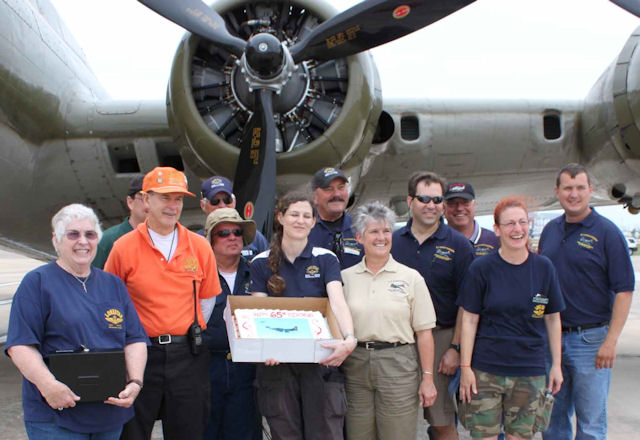
Lone Star Flight Museum: Thunderbird's 65th Birthday Party
The LSFM's B-17, painted with the markings of 303rd BG B-17G #42-38050 "Thunderbird" turned 65 years old on May 8th 2010. She rolled off the assembly line on V-E Day, May 8, 1945. (L-R) Judy Peters; Harry Lawrence; Tim Hahn, Pilot (behind Harry); Bill Reid, LSFM Mechanic (tan hat); Curt Nicholls (behind Bill); Susan Street (with the cake); John Sykes, Crew Chief; Debby Rihn-Harvey, Pilot; Larry Gregory, LSFM President; Rick Sharpe, Pilot; Emily McGowan; John Cowart, LSFM Head Mechanic
The family members of the 1Lt Vern L. Moncur Crew, the "Original Thunderbird Crew," will have a reunion at the Lone Star Flight Museum on Father's Day weekend. About 65 family members and close friends are planning to attend. The event will be capped off with a Hangar Dinner in the shadow of this beautiful plane.
 Vane Neville Leon Glendening, 87, of Old Miakka, FL, passed away June 5, 2010 at Sarasota Memorial Hospital, surrounded by family and friends.
He was born Feb. 3, 1923, in New Martinsville, W. Va.
Vane Neville Leon Glendening, 87, of Old Miakka, FL, passed away June 5, 2010 at Sarasota Memorial Hospital, surrounded by family and friends.
He was born Feb. 3, 1923, in New Martinsville, W. Va.
He served in the U.S. Army Air Corp during World War II as a flight engineer at the rank of staff sergeant. He flew on B-17s and B-24s with the 303rd Bomb Group, the Hells Angels, 427th Crew, and the 36th Bomb Group, the Secret Squadron, D-Day, the Schweinfurt-Regensburg mission, the Battle of the Bulge and other major operations. He married Dorothy Ellen Harvey from England and raised four children.
After his discharge, he was employed by the Pentagon, retiring from his position as assistant to the Chief of Naval Operations for the United States of America in 1973.
Mr. Glendening was a member of the Old Miakka Methodist Church and contributed time and money into building their Sunday school building, which was named after him.
He is preceded by his first wife, Dorothy, and sons Michael Glendening of Rockville, Md., and Carl Glendening.
He is survived by his second wife, Virginia; a daughter and son-in-law, Carol and Bill Abbott of Maryland; a daughter and son-in-law, Elaine and Moe Palmerton of Virginia; a son, Stephen Glendening of Bradenton; step-sons Phillip Rehberg of Bartow and Michael Rehberg of Lakeland; grandchildren Nicholas Glendening, Sharon Shirey, Matt Palmerton, Jim Neff, Char Glendening and Jennifer Harvey; step-grandchildren Toni Rehberg and Chris Roberts; and five great-grandchildren.
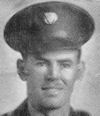 Eldon William Audiss, age 90, passed away on Monday, May 31, 2010, at Columbia Health Care Center, in Wyocena, WI.
Eldon was born on Oct. 23, 1919, in the Township of Moundville, Marquette County, the son of William and Anna (Hansen) Audiss. He graduated from the Endeavor Academy and Portage High School, participating in basketball and track.
Eldon William Audiss, age 90, passed away on Monday, May 31, 2010, at Columbia Health Care Center, in Wyocena, WI.
Eldon was born on Oct. 23, 1919, in the Township of Moundville, Marquette County, the son of William and Anna (Hansen) Audiss. He graduated from the Endeavor Academy and Portage High School, participating in basketball and track.
Eldon served his country in the United States Army Air Corps, 8th Air Force, 303rd Bomb Group, known as "Hells Angels" 359th Squadron during World War II. Eldon served as a top turret gunner and engineer on the B-17 named the "Duchess." Eldon was stationed at Molesworth, England and participated in the first bombing raids across the English Channel to Europe, to open the way for land invasion. After accomplishing his 19 missions, and upon returning to the United States, Permanent Master Sergeant Audiss trained other Air Corps cadets in gunnery school at Avon Park Army Air Field in Florida. Eldon married Norma Elaine Clark, on Jan. 1, 1944. They lived in Avon Park, Fla., until his discharge from service. Among his service medals, he was awarded the Distinguished Flying Cross and four Oak Leaf Clusters.
After discharge, Eldon and Norma lived in Madison where he worked for Oscar Mayer as a meat cutter, a trade he learned from his Uncle Ray. He returned and worked the family farm in Moundville with his father, and later as a shift supervisor of ball powder for Olin Chemical at Badger Ordnance during the Korean conflict and Vietnam. During the interim of these conflicts he worked for Koenig Masonry of Endeavor and for Valda Plastering of Madison. He also constructed fire engines at Fall River. Eldon was an avid outdoorsman, trapper, fisherman, hunter and crack shot, and his family thinks of him as one of the last frontiersmen.
Eldon is survived by two daughters, Nancy (Richard) Meyer of Stoughton, and Sally (George) Frye of Buchanan, Mich.; a son, Jeffrey Audiss of Endeavor; six grandchildren, Andrea (Michael) Thomas nee Meyer of Stoughton, Derek Meyer of Madison, Joshua (Samatha Dustin) Audiss of Brodhead, Brian (Julie) Terry of South Bend, Ind., Steven (Theresa Mitchell) Terry of South Bend, Ind., and Rebekah (Ricky) Martin nee Terry of Fort Campbell, Ky.; two great-grandchildren, Zachary and Mikayla Thomas; his sister, Lola (Donald) Richardson of Ridgefield, Wash.; a brother, Eugene; along with many nieces and nephews.
Eldon was preceded in death by his parents; his wife, Norma; his sister, Ila (Marshall) Otis; a son-in-law, Gary Terry; two grandchildren, Todd Audiss and Jason Terry; and a great-granddaughter, Emma Thomas.
Funeral services will be held at 2 p.m. on Saturday, June 5, 2010, at MOUNDVILLE UNITED METHODIST CHURCH, with the Rev. Barbara Bolz officiating. Burial will follow, with Military Graveside Services, in Moundville Cemetery. Visitation will be held from 1 p.m. until the time of the service, at the church. Lunch for family and friends will be available following interment.
The Pflanz Mantey Mendrala Funeral Home in Portage is assisting the family. A memorial fund has been established in Eldon's name.
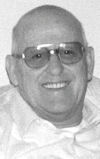 Arthur Lee "Pete" Bailey died June 2, 2010.
Art (Pete) Bailey was born in Tacoma, WA Sept. 19, 1924. Services will be held at St. John's Lutheran Church in Arroyo Grande, CA. Friday, June 11th at 3:00pm.
Arthur Lee "Pete" Bailey died June 2, 2010.
Art (Pete) Bailey was born in Tacoma, WA Sept. 19, 1924. Services will be held at St. John's Lutheran Church in Arroyo Grande, CA. Friday, June 11th at 3:00pm.
Art served in World War II in the 360th Bomb Squadron, assigned Nov. 12, 1944 as a Tail Gunner. He flew 30 combat missions over Nazi occupied Europe with the 1Lt Jack W. Weaver Crew.
Art was very involved with his family. He devoted countless hours to his Church, Grace Lutheran, as well as the North County Community Project helping the less fortunate. Art was a dedicated husband to his wife of 55 years, Mary Jane Leslie Bailey whom preceded him in death in 2000. Art later met and married Carollynne Blanchard Bailey whom he adored.
He is survived by his wife of 6 years Carollynne Bailey, two children Kenneth D. Bailey and his wife Mary (Chickie) Bailey of Milpitas, CA and Kathleen F. Johnston of Santa Maria, CA. Step Children Cindy Blanchard of Arroyo Grande, CA and Daniella Blanchard of Arroyo Grande, CA. Grandchildren, Kellie F. Vallianos and her husband Denis Vallianos of Florida, Danielle Martig and her husband Mike Martig of Roseville, CA, Lorianne Cornwell and her husband Steve Cornwell of Texas and Jill L. Johnston of Santa Maria, CA. Step Grandchildren Jamie Hall and Daniel R. Blanchard. Eight great-grandchildren and two step great-grandchildren.
Arrangements are in care of Dudley Hoffman Funeral Home and Crematory.
In lieu of flowers, contributions can be made to the Eighth Air Force Historical Society P.O. Box 956 Pooler, GA 31322 or to any Food Banks of Santa Barbara or San Luis Counties.
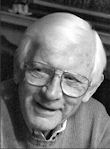 Stanley Wayne Lloyd –
Our beloved father, Stanley Wayne Lloyd, went to be with his Lord and Savior on Sunday, May 30, 2010. At his side were his wife of 62 years, Corinne Lloyd, son Noel Lloyd, daughter, Ramy Hardwick, daughter-in-law, Kate Lloyd, and grandson, Chris Lloyd.
Stanley Wayne Lloyd –
Our beloved father, Stanley Wayne Lloyd, went to be with his Lord and Savior on Sunday, May 30, 2010. At his side were his wife of 62 years, Corinne Lloyd, son Noel Lloyd, daughter, Ramy Hardwick, daughter-in-law, Kate Lloyd, and grandson, Chris Lloyd.
The only son of Charles and Alice Lloyd, Stan was born in Philips, South Dakota on November 5, 1921. At age 14, Stan's family, including sisters Fran, Betty and Gloria moved to Arlington, WA, where Stan graduated from Arlington High School class of 1939.
A WWII veteran, Stan served his country in the US Army Air Force in a B-17 Flying Fortress as a ball-turret gunner with the 303rd (Hell's Angels) Bomb Group, 359th Squadron. The Air Force awarded his 32 missions with the Air Medal, three Oak Leaf clusters and the Distinguished Flying Cross. On one mission Stan's plane was shot down over the English Channel. He was rescued and continued his service in other planes such as "The Bad Penny" – named for the old adage "a bad penny always returns."
After the war, Stan returned to Everett where he went to work for Chaffee's Department Store where he became vice-president. Stan was a member of Westminster Presbyterian Church for over 45 years where he served as Elder Emeritus. He was also a founding member of the Everett Rescue Mission. He also enjoyed the fellowship and friends of Everett's oldest coffee klatch for over 60 years.
Stan was preceded in death by sisters, Fran Osterman and Betty Haven; and baby granddaughter, Elizabeth Hardwick.
He is survived by his wife, Corinne Lloyd, son, Noel (Kate) Lloyd and their two sons, Chris Lloyd and Bryan (Sarah) Redecker and great-grandson, Sean, as well as daughter, Ramy Hardwick and her son, John Hardwick, Jr.
He also leaves behind sister, Gloria; brothers-in-law, John Osterman, Bob Haven, William Griffith, David Griffith and their families; as well as many nieces and nephews who absolutely adored him.
Stan gave to his wife and kids the best gift a man can give – unconditional love.
His favorite Bible verse was Nahum 1:7 "The Lord is good, a stronghold in the day of trouble, and He knoweth those who trust him."
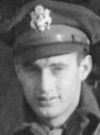
Robert A. Finley died May 26, 2010 in Palm Harbor, Florida. He was the bombardier on the 360th BS 1Lt John F. Coppom Crew, as well as other 360th BS crews, completing 30 combat missions.
Dear Gary,Keeping the Legacy Alive,Yesterday was an American holiday, Memorial Day. On this day we remember those who have given their lives while serving in the armed forces.
I fear that a great many Americans (perhaps even a large majority) only see Memorial Day as an extra day off from work -- a three day weekend of entertainment and recreation. This lack of gratitude -- this irreverence for things sacred -- is distressing to me . . . I for one would just like to publicly say "Thank You" . . .
To all the wives who have lost husbands,
To all the husbands who have lost wives,
To all the children who have lost mothers and fathers,
To all the parents who have lost their dear children (I can't imagine your pain),
To everyone who has lost a sister, brother, aunt, uncle, grandmother, grandfather or dear friend,
And especially to all the men and women who have sacrificed your lives, giving up everything you hoped and dreamed for in your future.
To all who have given so much so that my family and I can continue living under the banner of freedom . . .
Thank you.
Yours is a debt I can never repay, but I promise I will never forget nor take for granted your sacrifice for your country, and for me.
God bless you and your families
Sincerely, Ricky Brandon

|